Lenovo T420i, T420, T420S-4171, 4236X29, 4236WA4PC11B760 User Manual
...
User Guide
ThinkPad T420 and T420i
Notes: Before using this information and the product it supports, be sure to read the following:
•Safety and Warranty Guide
•Regulatory Notice
•“Important safety information” on page vi
•Appendix C “Notices” on page 249
The Safety and Warranty Guide and the Regulatory Notice have been uploaded on the Web site. To refer to them, go to http://www.lenovo.com/support, and then click User guides & manuals.
Second Edition (October 2011)
© Copyright Lenovo 2011.
LIMITED AND RESTRICTED RIGHTS NOTICE: If data or software is delivered pursuant a General Services Administration “GSA” contract, use, reproduction, or disclosure is subject to restrictions set forth in Contract No. GS-35F-05925.

Contents
Read this first . . . . . . . . . . . . . . |
v |
Important safety information . . . . . . . . . . |
vi |
Conditions that require immediate action . . |
vii |
Safety guidelines . . . . . . . . . . . . |
vii |
Chapter 1. Product Overview . . . . . . |
1 |
Locating computer controls, connectors, and |
|
indicators. . . . . . . . . . . . . . . . . . |
1 |
Front view. . . . . . . . . . . . . . . . |
2 |
Right-side view. . . . . . . . . . . . . . |
5 |
Left-side view . . . . . . . . . . . . . . |
7 |
Bottom view . . . . . . . . . . . . . . . |
8 |
Rear view . . . . . . . . . . . . . . . |
10 |
Status indicators . . . . . . . . . . . . |
11 |
Locating important product information . . . . . |
13 |
Machine type and model label. . . . . . . |
13 |
FCC ID and IC Certification number label . . |
14 |
Certificate of Authenticity label . . . . . . |
15 |
Features . . . . . . . . . . . . . . . . . |
16 |
Specifications . . . . . . . . . . . . . . . |
17 |
Operating environment . . . . . . . . . . . |
18 |
ThinkVantage Technologies and software . . . . |
18 |
Accessing applications in Windows 7 . . . . |
19 |
Access Connections . . . . . . . . . . |
20 |
Active Protection System. . . . . . . . . |
21 |
Client Security Solution . . . . . . . . . |
21 |
Fingerprint Software. . . . . . . . . . . |
21 |
Lenovo Solution Center . . . . . . . . . |
22 |
Lenovo ThinkVantage Tools . . . . . . . . |
22 |
Lenovo ThinkVantage Toolbox . . . . . . . |
22 |
Message Center Plus . . . . . . . . . . |
22 |
Password Manager . . . . . . . . . . . |
23 |
Power Manager . . . . . . . . . . . . |
23 |
Presentation Director . . . . . . . . . . |
23 |
Product Recovery . . . . . . . . . . . |
23 |
Rescue and Recovery . . . . . . . . . . |
23 |
SimpleTap . . . . . . . . . . . . . . |
24 |
System Update . . . . . . . . . . . . |
24 |
ThinkVantage GPS . . . . . . . . . . . |
24 |
ThinkVantage Productivity Center . . . . . |
24 |
Chapter 2. Using your computer . . . |
25 |
Register your computer . . . . . . . . . . . |
25 |
Frequently asked questions . . . . . . . . . |
25 |
Special keys and buttons . . . . . . . . . . |
27 |
ThinkVantage button . . . . . . . . . . |
27 |
Numeric keypad . . . . . . . . . . . . |
27 |
Function key combinations . . . . . . . . |
28 |
Volume and mute buttons . . . . . . . . |
32 |
Windows key and Application key . . . . . |
33 |
Using the UltraNav pointing device. . . . . . . |
34 |
Using the TrackPoint pointing device . . . . |
34 |
Using the touch pad. . . . . . . . . . . |
36 |
Behavior of the UltraNav and an external |
|
mouse . . . . . . . . . . . . . . . . |
37 |
Adding the UltraNav icon to the system tray . |
37 |
Power management . . . . . . . . . . . . |
38 |
Checking battery status . . . . . . . . . |
38 |
Using the ac power adapter. . . . . . . . |
38 |
Charging the battery . . . . . . . . . . |
39 |
Maximizing battery life . . . . . . . . . . |
39 |
Managing your battery power . . . . . . . |
39 |
Power-saving modes . . . . . . . . . . |
39 |
Handling the battery. . . . . . . . . . . |
41 |
Connecting to the network . . . . . . . . . . |
42 |
Ethernet connections . . . . . . . . . . |
42 |
Wireless connections . . . . . . . . . . |
43 |
Using the built-in modem. . . . . . . . . |
50 |
Using a projector or external display . . . . . . |
69 |
Changing display settings . . . . . . . . |
69 |
Connecting a projector or external display . . |
70 |
Setting up a presentation. . . . . . . . . |
74 |
Using dual displays . . . . . . . . . . . |
75 |
Using the NVIDIA Optimus Graphics feature . . . |
76 |
Using audio features . . . . . . . . . . . . |
77 |
Using an integrated camera . . . . . . . . . |
78 |
Using the ThinkLight feature . . . . . . . . . |
78 |
Using the optical drive . . . . . . . . . . . |
79 |
Using the media card reader . . . . . . . . . |
79 |
Inserting an ExpressCard, a flash media card, |
|
or a smart card. . . . . . . . . . . . . |
79 |
Removing an ExpressCard, a flash media card |
|
or a smart card. . . . . . . . . . . . . |
80 |
Chapter 3. You and your computer . |
. |
83 |
Accessibility and comfort . . . . . . . . . |
. |
83 |
Ergonomic information. . . . . . . . . |
. |
83 |
Adjusting your computer to fit you . . . . |
. |
84 |
Accessibility information . . . . . . . . |
. |
85 |
FullScreen Magnifier function . . . . . . |
. |
85 |
Traveling with your computer . . . . . . . . |
. |
86 |
Travel tips . . . . . . . . . . . . . . |
. |
86 |
Travel accessories . . . . . . . . . . |
. |
86 |
© Copyright Lenovo 2011 |
i |
Chapter 4. Security . . . . . . . . . . |
89 |
Attaching a mechanical lock . . . . . . . . . |
89 |
Using passwords. . . . . . . . . . . . . . |
89 |
Passwords and sleep (standby) mode . . . . |
90 |
Typing passwords . . . . . . . . . . . |
90 |
Power-on password . . . . . . . . . . . |
90 |
Hard disk passwords . . . . . . . . . . |
91 |
Supervisor password . . . . . . . . . . |
93 |
Hard disk security . . . . . . . . . . . . . |
95 |
Setting the security chip . . . . . . . . . . . |
96 |
Using a fingerprint reader . . . . . . . . . . |
97 |
Notice on deleting data from your hard disk drive |
|
or solid state drive . . . . . . . . . . . . . |
100 |
Using and understanding firewalls . . . . . . . |
100 |
Protecting data against viruses . . . . . . . . |
101 |
Chapter 5. Recovery overview . . . |
103 |
Creating and using recovery media . . . . . . |
103 |
Creating recovery media . . . . . . . . . |
104 |
Using recovery media . . . . . . . . . . |
104 |
Performing backup and recovery operations . . . 105
Performing a backup operation . . . . . . |
105 |
Performing a recovery operation . . . . . . |
105 |
Using the Rescue and Recovery workspace . . . 106
Creating and using a rescue medium . . . . . . |
107 |
Creating a rescue medium . . . . . . . . |
107 |
Using a rescue medium . . . . . . . . . |
107 |
Reinstalling preinstalled applications and device |
|
drivers . . . . . . . . . . . . . . . . . . |
108 |
Solving recovery problems . . . . . . . . . . |
109 |
Chapter 6. Replacing devices . . . . |
111 |
Static electricity prevention. . . . . . . . . . |
111 |
Replacing the battery . . . . . . . . . . . . |
111 |
Replacing the hard disk drive . . . . . . . . . |
115 |
Replacing the keyboard . . . . . . . . . . . |
119 |
Replacing memory . . . . . . . . . . . . . |
123 |
Installing and replacing the mSATA solid state |
|
drive. . . . . . . . . . . . . . . . . . . |
127 |
Installing and replacing a PCI Express Mini Card |
|
for wireless LAN/WiMAX connection . . . . . . |
130 |
Installing and replacing the PCI Express Mini Card |
|
for wireless WAN . . . . . . . . . . . . . . |
137 |
Replacing the SIM card . . . . . . . . . . . |
142 |
Replacing the solid state drive . . . . . . . . |
143 |
Chapter 7. Enhancing your |
|
computer . . . . . . . . . . . . . . |
149 |
Finding ThinkPad options . . . . . . . . . . |
149 |
Using the serial Ultrabay enhanced . . . . . . |
149 |
Replacing the device . . . . . . . . . . |
149 |
Performing a hot swap . . . . . . . . . . |
150 |
Performing a warm swap . . . . . . . . . 151
Inserting the hard disk drive into the
adapter . . . . . . . . . . . . . . . . 153
Inserting the hard disk drive adapter into the
bay . . . . . . . . . . . . . . . . . 155
ThinkPad Port Replicator Series 3, ThinkPad Mini Dock Series 3, ThinkPad Mini Dock Plus Series 3,
and ThinkPad Mini Dock Plus Series 3 (170 W) . . 156
Front view. . . . . . . . . . . . . . . 156
Rear view . . . . . . . . . . . . . . . 159
Attaching a ThinkPad Port Replicator Series 3, ThinkPad Mini Dock Series 3, ThinkPad Mini Dock Plus Series 3, or ThinkPad Mini Dock
Plus Series 3 (170 W) . . . . . . . . . . 162
Detaching a ThinkPad Port Replicator Series 3, ThinkPad Mini Dock Series 3, ThinkPad Mini Dock Plus Series 3, or the ThinkPad Mini
Dock Plus Series 3 (170 W) . . . . . . . . 164
Security feature . . . . . . . . . . . . 166
Using the system lock key . . . . . . . . 168
Chapter 8. Advanced
configuration . . . . . . . . . . . . 169
Installing a new operating system . . . . . . . 169
Before you begin . . . . . . . . . . . . 169
Installing Windows 7 . . . . . . . . . . 170
Installing Windows Vista . . . . . . . . . 171
Installing Windows XP . . . . . . . . . . 172
Installing device drivers . . . . . . . . . . . 175
Installing the driver for the 4-in-1 Media Card Reader . . . . . . . . . . . . . . . . 175
Installing ThinkPad Monitor File for Windows 2000/XP/Vista/7 . . . . . . . . . . . . 175
ThinkPad Setup . . . . . . . . . . . . . . 177
Config menu. . . . . . . . . . . . . . 177
Date and time menu. . . . . . . . . . . 178
Security menu . . . . . . . . . . . . . 178
Startup menu . . . . . . . . . . . . . 179
Restart menu . . . . . . . . . . . . . 181
ThinkPad Setup items . . . . . . . . . . 181
Updating your system UEFI BIOS . . . . . 191
Using system management. . . . . . . . . . 192
System management . . . . . . . . . . 192
Setting management features . . . . . . . 193
Chapter 9. Preventing problems . . 195
General tips for preventing problems . . . . . . 195
Making sure device drivers are current . . . . . 196
Getting the latest drivers from the Web site . . 196
Getting the latest drivers using System
Update . . . . . . . . . . . . . . . . 196
Taking care of your computer . . . . . . . . . 196
Cleaning the cover of your computer . . . . 199
ii User Guide

Chapter 10. Troubleshooting |
|
computer problems . . . . . . . . . |
201 |
Diagnosing problems . . . . . . . . . . . . |
201 |
Troubleshooting . . . . . . . . . . . . . . |
202 |
Computer stops responding . . . . . . . |
202 |
Spills on the keyboard . . . . . . . . . . |
203 |
Error messages . . . . . . . . . . . . |
203 |
Errors without messages . . . . . . . . . |
205 |
Beep errors . . . . . . . . . . . . . . |
206 |
Memory problems . . . . . . . . . . . |
207 |
Modem and networking . . . . . . . . . |
207 |
Keyboard and other pointing devices . . . . 214 |
|
Display and multimedia devices . . . . . . |
215 |
Fingerprint reader problems. . . . . . . . |
225 |
Battery and power . . . . . . . . . . . |
225 |
Drives and other storage devices . . . . . |
229 |
Software problems . . . . . . . . . . . |
231 |
Ports and connectors . . . . . . . . . . |
231 |
Universal Serial Bus problems . . . . . . . |
232 |
A docking station or port replicator |
|
problem . . . . . . . . . . . . . . . |
232 |
Chapter 11. Getting support . . . . |
233 |
Before you contact Lenovo . . . . . . . . . . |
233 |
Register your computer . . . . . . . . . |
233 |
Download system updates . . . . . . . . |
233 |
Record information . . . . . . . . . . . |
233 |
Getting help and service . . . . . . . . . . . |
234 |
Using diagnostic programs . . . . . . . . |
234 |
Lenovo Support Web site. . . . . . . . . |
234 |
Calling Lenovo . . . . . . . . . . . . . |
234 |
Purchasing additional services . . . . . . . . |
235 |
Appendix A. Regulatory |
|
information . . . . . . . . . . . . . |
237 |
Wireless related information . . . . . . . . . |
237 |
Location of the UltraConnect wireless |
|
antennas . . . . . . . . . . . . . . . |
238 |
Locating wireless regulatory notices . . . . |
240 |
Export classification notice . . . . . . . . . . |
241 |
Electronic emission notices. . . . . . . . . . |
241 |
Federal Communications Commission |
|
Declaration of Conformity . . . . . . . . |
241 |
Industry Canada Class B emission compliance |
|
statement . . . . . . . . . . . . . . . |
241 |
European Union - Compliance to the |
|
Electromagnetic Compatibility Directive . . . |
241 |
German Class B compliance statement . . . |
242 |
Korea Class B compliance statement . . . . |
242 |
Japanese VCCI Class B statement . . . . . |
243 |
Japan compliance statement for products |
|
which connect to the power mains with |
|
rated current less than or equal to 20 A per |
|
phase . . . . . . . . . . . . . . . . |
243 |
Lenovo product service information for |
|
Taiwan . . . . . . . . . . . . . . . . |
243 |
Additional regulatory information . . . . . . . |
243 |
Appendix B. WEEE and recycling |
|
statements . . . . . . . . . . . . . |
245 |
Important WEEE Information . . . . . . . . . |
245 |
Battery recycling information for Japan . . . . . |
245 |
Battery recycling information for Brazil . . . . . |
246 |
Battery recycling information for Taiwan . . . . . |
246 |
Battery recycling information for European |
|
Union . . . . . . . . . . . . . . . . . . |
247 |
Battery recycling information for United States and |
|
Canada . . . . . . . . . . . . . . . . . |
247 |
Appendix C. Notices. . . . . . . . . |
249 |
Trademarks . . . . . . . . . . . . . . . . |
250 |
Appendix D. Restriction of Hazardous |
|
Substances Directive (RoHS) . . . . |
251 |
China RoHS. . . . . . . . . . . . . . . . |
251 |
Turkish RoHS . . . . . . . . . . . . . . . |
251 |
Ukraine RoHS . . . . . . . . . . . . . . . |
251 |
India RoHS . . . . . . . . . . . . . . . . |
252 |
© Copyright Lenovo 2011 |
iii |
iv User Guide
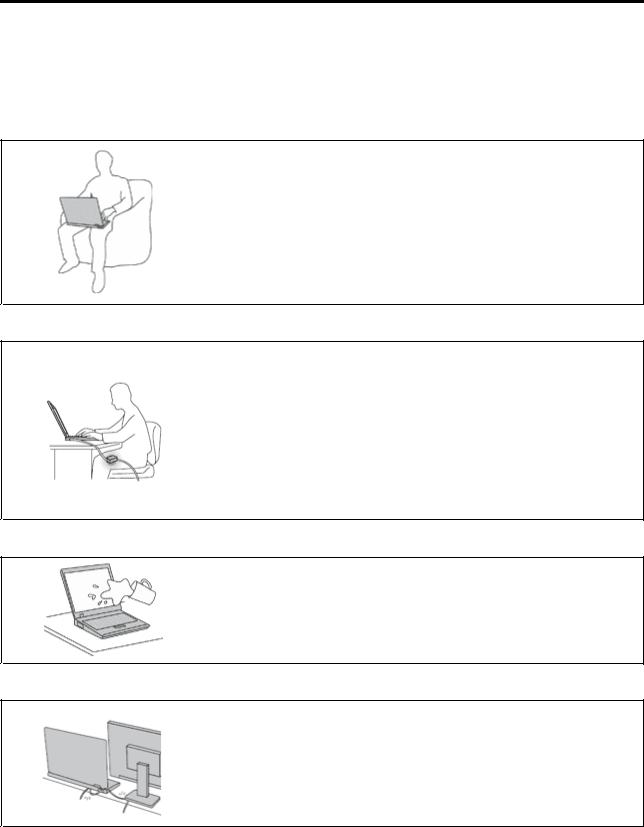
Read this first
Be sure to follow the important tips given here to continue to get the most use and enjoyment out of your computer. Failure to do so might lead to discomfort or injury, or cause your computer to fail.
Protect yourself from the heat that your computer generates.
When your computer is turned on or the battery is charging, the base, the palm rest, and some other parts may become hot. The temperature they reach depends on the amount of system activity and the level of charge in the battery.
Extended contact with your body, even through clothing, could cause discomfort or even a skin burn.
•Avoid keeping your hands, your lap, or any other part of your body in contact with a hot section of the computer for any extended time.
•Periodically take hands from using the keyboard by lifting your hands from the palm rest.
Protect yourself from the heat generated by the ac power adapter.
When the ac power adapter is connected to an electrical outlet and your computer, it generates heat.
Extended contact with your body, even through clothing, may cause a skin burn.
•Do not place the ac power adapter in contact with any part of your body while it is in use.
•Never use it to warm your body.
Prevent your computer from getting wet.
•To avoid spills and the danger of electrical shock, keep liquids away from your computer.
Protect the cables from being damaged.
Applying strong force to cables may damage or break them.
•Route communication lines, or the cables of an ac power adapter, a mouse, a keyboard, a printer, or any other electronic device, so that they cannot be walked on, tripped over, pinched by your computer or other objects, or in any way subjected to treatment that could interfere with the operation of your computer.
© Copyright Lenovo 2011 |
v |
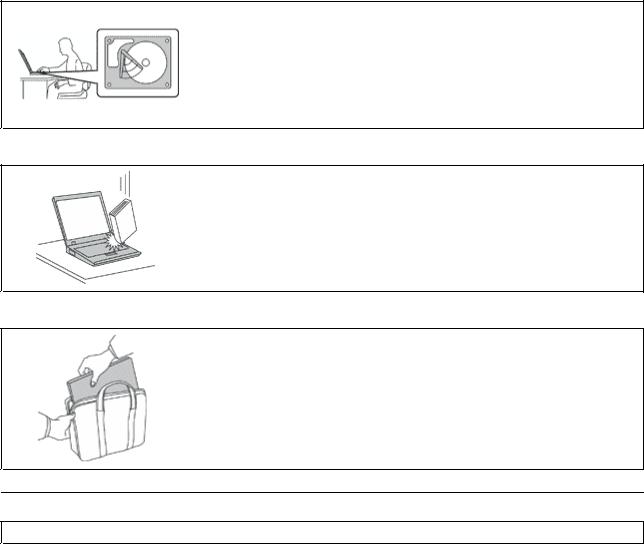
Protect your computer and data when moving it.
Before moving a computer equipped with a hard disk drive, do one of the following, and make sure that the power switch is off or is blinking:
•Turn it off.
•Press Fn+F4 to put it in sleep (standby) mode
•Press Fn+F12 to put it in hibernation mode.
This will help to prevent damage to the computer, and possible loss of data.
Handle your computer gently.
•Do not drop, bump, scratch, twist, hit, vibrate, push, or place heavy objects on your computer, display, or external devices.
Carry your computer carefully.
•Use a quality carrying case that provides adequate cushioning and protection.
•Do not pack your computer in a tightly packed suitcase or bag.
•Before putting your computer in a carrying case, make sure that it is off, in sleep (standby) mode (Fn+F4), or in hibernation mode (Fn+F12). Do not put a computer in a carrying case while it is turned on.
Important safety information
Note: Read important safety information first.
This information can help you safely use your notebook personal computer. Follow and retain all information included with your computer. The information in this document does not alter the terms of your purchase agreement or the Lenovo Limited Warranty. For more information, see the Safety and Warranty Guide came with your computer.
Customer safety is important. Our products are developed to be safe and effective. However, personal computers are electronic devices. Power cords, power adapters, and other features can create potential safety risks that can result in physical injury or property damage, especially if misused. To reduce these risks, follow the instructions included with your product, observe all warnings on the product and in the operating instructions, and review the information included in this document carefully. By carefully following the information contained in this document and provided with your product, you can help protect yourself from hazards and create a safer computer work environment.
Note: This information includes references to power adapters and batteries. In addition to notebook computers, some products (such as speakers and monitors) ship with external power adapters. If you have such a product, this information applies to your product. In addition, computer products contain a coin-sized internal battery that provides power to the system clock even when the computer is unplugged, so the battery safety information applies to all computer products.
vi User Guide
Conditions that require immediate action
Products can become damaged due to misuse or neglect. Some product damage is serious enough that the product should not be used again until it has been inspected and, if necessary, repaired by an authorized servicer.
As with any electronic device, pay close attention to the product when it is turned on. On very rare occasions, you might notice an odor or see a puff of smoke or sparks vent from your product. Or you might hear sounds like popping, cracking or hissing. These conditions might merely mean that an internal electronic component has failed in a safe and controlled manner. Or, they might indicate
a potential safety issue. However, do not take risks or attempt to diagnose the situation yourself. Contact the Customer Support Center for further guidance. For a list of Service and Support phone numbers, see the following Web site: http://www.lenovo.com/support/phone.
Frequently inspect your computer and its components for damage or wear or signs of danger. If you have any question about the condition of a component, do not use the product. Contact the Customer Support Center or the product manufacturer for instructions on how to inspect the product and have it repaired, if necessary.
In the unlikely event that you notice any of the following conditions, or if you have any safety concerns with your product, stop using the product and unplug it from the power source and telecommunication lines until you can speak to the Customer Support Center for further guidance.
•Power cords, plugs, power adapters, extension cords, surge protectors, or power supplies that are cracked, broken, or damaged.
•Signs of overheating, smoke, sparks, or fire.
•Damage to a battery (such as cracks, dents, or creases), discharge from a battery, or a buildup of foreign substances on the battery.
•A cracking, hissing or popping sound, or strong odor that comes from the product.
•Signs that liquid has been spilled or an object has fallen onto the computer product, the power cord or power adapter.
•The computer product, power cord, or power adapter has been exposed to water.
•The product has been dropped or damaged in any way.
•The product does not operate normally when you follow the operating instructions.
Note: If you notice these conditions with a product (such as an extension cord) that is not manufactured for or by Lenovo, stop using that product until you can contact the product manufacturer for further instructions, or until you get a suitable replacement.
Safety guidelines
Always observe the following precautions to reduce the risk of injury and property damage.
For more information, see the Safety and Warranty Guide came with your computer.
Service and upgrades
Do not attempt to service a product yourself unless instructed to do so by the Customer Support Center or your documentation. Only use a Service Provider who is approved to repair your particular product.
Note: Some computer parts can be upgraded or replaced by the customer. Upgrades typically are referred to as options. Replacement parts approved for customer installation are referred to as Customer Replaceable Units, or CRUs. Lenovo provides documentation with instructions when it is appropriate for customers to install options or replace CRUs. You must closely follow all instructions when installing or replacing parts. The Off state of a power indicator does not necessarily mean that voltage levels inside a
© Copyright Lenovo 2011 |
vii |
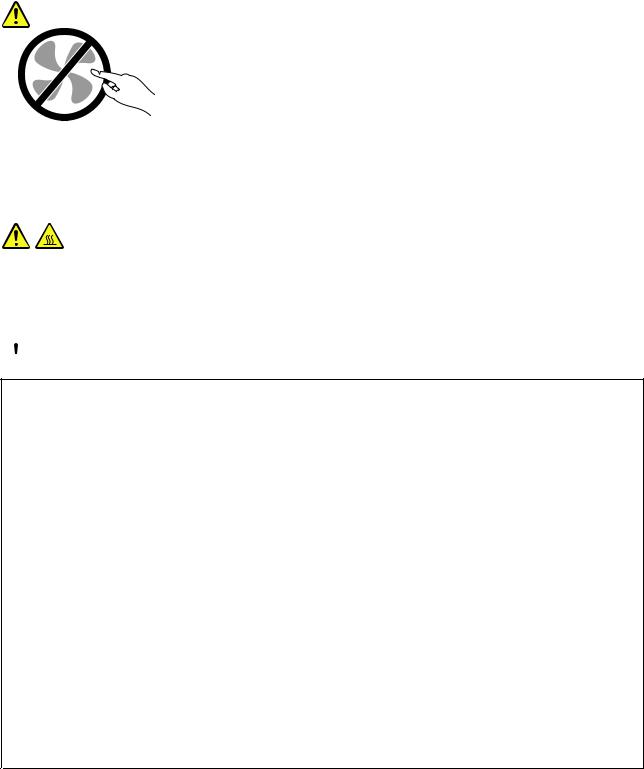
product are zero. Before you remove the covers from a product equipped with a power cord, always make sure that the power is turned off and that the product is unplugged from any power source. If you have any questions or concerns, contact the Customer Support Center.
Although there are no moving parts in your computer after the power cord has been disconnected, the following warnings are required for your safety.
CAUTION:
Hazardous moving parts. Keep fingers and other body parts away.
CAUTION:
Before replacing any CRUs, turn off the computer and wait three to five minutes to let the computer cool before opening the cover.
Power cords and power adapters
 DANGER
DANGER
Use only the power cords and power adapters supplied by the product manufacturer.
The power cords shall be safety approved. For Germany, it shall be H05VV-F, 3G, 0.75 mm2, or better. For other countries, the suitable types shall be used accordingly.
Never wrap a power cord around a power adapter or other object. Doing so can stress the cord in ways that can cause the cord to fray, crack, or crimp. This can present a safety hazard.
Always route power cords so that they will not be walked on, tripped over, or pinched by objects.
Protect power cord and power adapters from liquids. For instance, do not leave your power cord or power adapter near sinks, tubs, toilets, or on floors that are cleaned with liquid cleansers. Liquids can cause a short circuit, particularly if the power cord or power adapter has been stressed by misuse. Liquids also can cause gradual corrosion of power cord terminals and/or the connector terminals on a power adapter, which can eventually result in overheating.
Always connect power cords and signal cables in the correct order and ensure that all power cord connectors are securely and completely plugged into receptacles.
Do not use any power adapter that shows corrosion at the AC input pins or shows signs of overheating (such as deformed plastic) at the AC input or anywhere on the power adapter.
Do not use any power cords where the electrical contacts on either end show signs of corrosion or overheating or where the power cord appears to have been damaged in any way.
viii User Guide
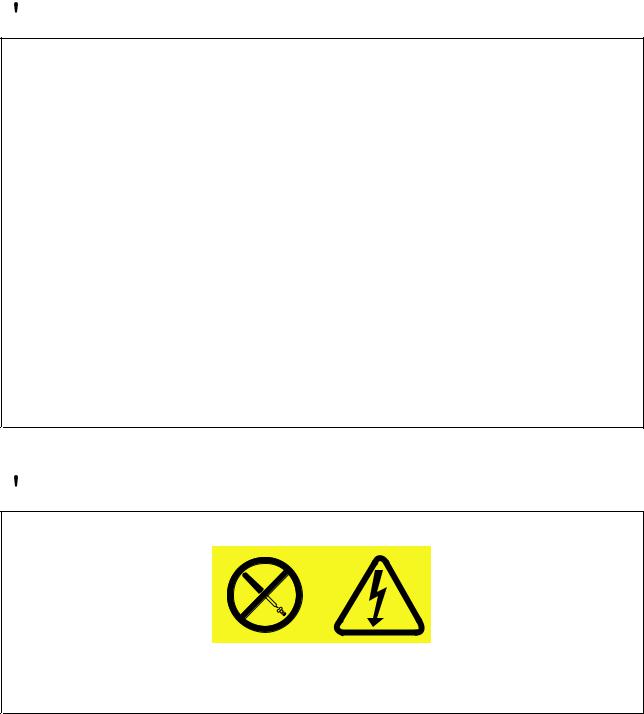
Extension cords and related devices
Ensure that extension cords, surge protectors, uninterruptible power supplies, and power strips that you use are rated to handle the electrical requirements of the product. Never overload these devices. If power strips are used, the load should not exceed the power strip input rating. Consult an electrician for more information if you have questions about power loads, power requirements, and input ratings.
Plugs and outlets
 DANGER
DANGER
If a receptacle (power outlet) that you intend to use with your computer equipment appears to be damaged or corroded, do not use the outlet until it is replaced by a qualified electrician.
Do not bend or modify the plug. If the plug is damaged, contact the manufacturer to obtain a replacement.
Do not share an electrical outlet with other home or commercial appliances that draw large amounts of electricity; otherwise, unstable voltage might damage your computer, data, or attached devices.
Some products are equipped with a three-pronged plug. This plug fits only into a grounded electrical outlet. This is a safety feature. Do not defeat this safety feature by trying to insert it into a non-grounded outlet. If you cannot insert the plug into the outlet, contact an electrician for an approved outlet adapter or to replace the outlet with one that enables this safety feature. Never overload an electrical outlet. The overall system load should not exceed 80 percent of the branch circuit rating. Consult an electrician for more information if you have questions about power loads and branch circuit ratings.
Be sure that the power outlet you are using is properly wired, easily accessible, and located close to the equipment. Do not fully extend power cords in a way that will stress the cords.
Be sure that the power outlet provides the correct voltage and current for the product you are installing.
Carefully connect and disconnect the equipment from the electrical outlet.
Power supply statement
 DANGER
DANGER
Never remove the cover on a power supply or any part that has the following label attached.
Hazardous voltage, current, and energy levels are present inside any component that has this label attached. There are no serviceable parts inside these components. If you suspect a problem with one of these parts, contact a service technician.
© Copyright Lenovo 2011 |
ix |

External devices
CAUTION:
Do not connect or disconnect any external device cables other than Universal Serial Bus (USB) and 1394 cables while the computer power is on; otherwise, you might damage your computer. To avoid possible damage to attached devices, wait at least five seconds after the computer is shut down to disconnect external devices.
Batteries
 DANGER
DANGER
Personal computers manufactured by Lenovo contain a coin cell battery to provide power to the system clock. In addition, many mobile products, such as notebook computers, utilize a
rechargeable battery pack to provide system power when in portable mode. Batteries supplied by Lenovo for use with your product have been tested for compatibility and should only be replaced with approved parts.
This system does not support batteries that are not genuine Lenovo-made or authorized. The system will continue to boot, but may not charge unauthorized batteries. Attention: Lenovo has no responsibility for the performance or safety of unauthorized batteries, and provides no warranties for failures or damage arising out of their use.
Never attempt to open or service any battery. Do not crush, puncture, or incinerate batteries or short circuit the metal contacts. Do not expose the battery to water or other liquids. Only recharge the battery pack strictly according to instructions included in the product documentation.
Battery abuse or mishandling can cause the battery to overheat, which can cause gasses or flame to “vent” from the battery pack or coin cell. If your battery is damaged, or if you notice any discharge from your battery or the buildup of foreign materials on the battery leads, stop using the battery and obtain a replacement from the battery manufacturer.
Batteries can degrade when they are left unused for long periods of time. For some rechargeable batteries (particularly Lithium Ion batteries), leaving a battery unused in a discharged state could increase the risk of a battery short circuit, which could shorten the life of the battery and can also pose a safety hazard. Do not let rechargeable Lithium-Ion batteries completely discharge or store these batteries in a discharged state.
Rechargeable battery notice
 DANGER
DANGER
Do not attempt to disassemble or modify the battery pack. Attempting to do so can cause an explosion, or liquid leakage from the battery pack. A battery pack other than the one specified by Lenovo, or a disassembled or modified battery pack is not covered by the warranty.
If the rechargeable battery pack is incorrectly replaced, there is danger of an explosion. The battery pack contains a small amount of harmful substances. To avoid possible injury:
•Replace only with a battery of the type recommended by Lenovo.
•Keep the battery pack away from fire.
•Do not expose it to water or rain.
•Do not attempt to disassemble it.
•Do not short-circuit it.
x User Guide

•Keep it away from children.
•Do not drop the battery pack.
Do not put the battery pack in trash that is disposed of in landfills. When disposing of the battery, comply with local ordinances or regulations.
The battery pack should be stored at room temperature, charged to approximately 30 to 50% of capacity. We recommend that battery pack be charged about once per year to prevent overdischarge.
Lithium coin cell battery notice
 DANGER
DANGER
Danger of explosion if battery is incorrectly replaced.
When replacing the lithium coin cell battery, use only the same or an equivalent type that is recommended by the manufacturer. The battery contains lithium and can explode if not properly used, handled, or disposed of.
Do not:
•Throw or immerse into water
•Heat to more than 100°C (212°F)
•Repair or disassemble
Dispose of the battery as required by local ordinances or regulations.
The following statement applies to users in the state of California, U.S.A.
California Perchlorate Information:
Products containing CR (manganese dioxide) lithium coin cell batteries may contain perchlorate.
Perchlorate Material - special handling may apply. See
http://www.dtsc.ca.gov/hazardouswaste/perchlorate.
Heat and product ventilation
 DANGER
DANGER
Computers, ac power adapters, and many accessories can generate heat when turned on and when batteries are charging. Notebook computers can generate a significant amount of heat due to their compact size. Always follow these basic precautions:
•When your computer is turned on or the battery is charging, the base, the palm rest, and some other parts may become hot. Avoid keeping your hands, your lap, or any other part of your body in contact with a hot section of the computer for any extended length of time. When you use the keyboard, avoid keeping your palms on the palm rest for a prolonged period of time. Your computer generates some heat during normal operation. The amount of heat depends on the amount of system activity and the battery charge level. Extended contact with your body, even through clothing, could cause discomfort or even a skin burn. Periodically take breaks
© Copyright Lenovo 2011 |
xi |

from using the keyboard by lifting your hands from the palm rest; and be careful not to use the keyboard for any extended length of time.
•Do not operate your computer or charge the battery near flammable materials or in explosive environments.
•Ventilation slots, fans and/or heat sinks are provided with the product for safety, comfort, and reliable operation. These features might inadvertently become blocked by placing the product on a bed, sofa, carpet, or other flexible surface. Never block, cover, or disable these features.
•When the ac power adapter is connected to an electrical outlet and your computer, it generates heat. Do not place the adapter in contact with any part of your body while using it. Never use the ac power adapter to warm your body. Extended contact with your body, even through clothing, may cause a skin burn.
For your safety, always follow these basic precautions with your computer:
•Keep the cover closed whenever the computer is plugged in.
•Regularly inspect the outside of the computer for dust accumulation.
•Remove dust from vents and any perforations in the bezel. More frequent cleanings might be required for computers in dusty or high-traffic areas.
•Do not restrict or block any ventilation openings.
•Do not operate your computer inside furniture, as this might increase the risk of overheating.
•Airflow temperatures into the computer should not exceed 35° C (95° F).
Electrical current safety information
 DANGER
DANGER
Electric current from power, telephone, and communication cables is hazardous.
To avoid a shock hazard:
•Do not use your computer during a lightning storm.
•Do not connect or disconnect any cables or perform installation, maintenance, or reconfiguration of this product during an electrical storm.
•Connect all power cords to a properly wired and grounded electrical outlet.
•Connect to properly wired outlets any equipment that will be attached to this product.
•Whenever possible, use one hand only to connect or disconnect signal cables.
•Never turn on any equipment when there is evidence of fire, water, or structural damage.
•Disconnect the attached power cords, battery pack, and all the cables before you open the device covers, unless instructed otherwise in the installation and configuration procedures.
•Do not use you computer until all internal parts enclosures are fastened into place. Never use the computer when internal parts and circuits are exposed.
xii User Guide

 DANGER
DANGER
•Connect and disconnect cables as described in the following procedures when installing, moving, or opening covers on this product or attached devices.
To connect:
1.Turn everything OFF.
2.First, attach all cables to devices.
3.Attach signal cables to connectors.
4.Attach power cords to outlets.
5.Turn devices ON.
To disconnect:
1.Turn everything OFF.
2.First, remove power cords from outlets.
3.Remove signal cables from connectors.
4.Remove all cables from devices.
The power cord must be disconnected from the wall outlet or receptacle before installing all other electrical cables connected to the computer.
The power cord may be reconnected to the wall outlet or receptacle only after all other electrical cables have been connected to the computer.
Modem safety information
 DANGER
DANGER
For North America Type:
CAUTION:
To reduce the risk of fire, use only No. 26 AWG or larger (for example, No. 24 AWG) telecommunication line cord listed by Underwriters Laboratories (UL) or certified by the Canadian Standards Association (CSA).
To reduce the risk of fire, electrical shock, or injury when using telephone equipment, always follow basic safety precautions as the following:
•Do not connect the cable to or disconnect it from the telephone outlet on the wall during a lightning storm.
•Do not install telephone jacks in wet locations. Do not use your computer near water.
•Do not touch uninsulated telephone wires or terminals unless the telephone line has been disconnected at the network interface.
•Use caution when installing or modifying telephone lines.
•Do not use your computer with the telephone cable connection during an electrical storm. There may be a remote risk of electric shock from lightning.
•Do not use a telephone (other than a cordless type) during an electrical storm.
•Do not use the telephone to report a gas leak in the vicinity of the leak.
•Do not connect the telephone cable to the Ethernet connector.
Laser compliance statement
CAUTION:
When laser products (such as CD-ROMs, DVD drives, fiber optic devices, or transmitters) are installed, note the following:
•Do not remove the covers. Removing the covers of the laser product could result in exposure to hazardous laser radiation. There are no serviceable parts inside the device.
© Copyright Lenovo 2011 |
xiii |

•Use of controls or adjustments or performance of procedures other than those specified herein might result in hazardous radiation exposure.
 DANGER
DANGER
Some laser products contain an embedded Class 3A or Class 3B laser diode. Note the following.
Laser radiation when open. Do not stare into the beam, do not view directly with optical instruments, and avoid direct exposure to the beam.
Liquid crystal display (LCD) notice
CAUTION:
For products with mercury-containing fluorescent lamps (i.e., non-LED)
•The fluorescent lamp in the liquid crystal display contains mercury; dispose according to local, state, or federal laws.
•The LCD is made of glass, and rough handling or dropping the computer can cause the LCD to break. If the LCD breaks and the internal fluid gets into your eyes or on your hands, immediately wash the affected areas with water for at least 15 minutes; if any symptoms are present after washing, get medical care.
Using headphones or earphones
If your computer has both a headphone connector and an audio-out connector, always use the headphone connector for headphones (also called a headset) or earphones.
CAUTION:
Excessive sound pressure from earphones and headphones can cause hearing loss. Adjustment of the equalizer to maximum increases the earphones and headphones output voltage and therefore the sound pressure level.
Excessive use of headphones or earphones for a long period of time at high volume can be dangerous if the output of the headphone or earphone connectors do not comply with specifications of EN 50332-2. The headphone output connector of your computer complies with EN 50332-2 Sub clause 7. This specification limits the computer’s maximum wide band true RMS output voltage to 150 mV. To help protect against hearing loss, ensure that the headphones or earphones you use also comply with EN 50332-2 (Clause 7 limits) for a wide band characteristic voltage of 75 mV. Using headphones that do not comply with EN 50332-2 can be dangerous due to excessive sound pressure levels.
If your Lenovo computer came with headphones or earphones in the package, as a set, the combination of the headphones or earphones and the computer already complies with the specifications of EN 50332-1. If different headphones or earphones are used, ensure that they comply with EN 50332-1 (Clause 6.5 Limitation Values). Using headphones that do not comply with EN 50332-1 can be dangerous due to excessive sound pressure levels.
Additional safety information
 DANGER
DANGER
Plastic bags can be dangerous. Keep plastic bags away from babies and children to avoid danger of suffocation.
Notice for Tablet PC users
Safety Notice for users in Australia:
xiv User Guide

 DANGER
DANGER
Do not connect phone line while using tablet mode.
Notice for users in the U.S.A.
Many PC products and accessories contain cords, cables or wires, such as power cords or cords to connect the accessory to a PC. If this product has such a cord, cable or wire, then the following warning applies:
WARNING
Handling the cord on this product or cords associated with accessories sold with this product will expose you to lead, a chemical known to the State of California to cause cancer, and birth defects or other reproductive harm. Wash hands after handling.
Save these instructions.
© Copyright Lenovo 2011 |
xv |
xvi User Guide

Chapter 1. Product Overview
This chapter provides information about the locations of connectors, locating important product information, computer features, specifications, operating environment, and preinstalled software programs.
This chapter contains the following topics:
•“Locating computer controls, connectors, and indicators” on page 1
•“Locating important product information” on page 13
•“Features” on page 16
•“Specifications” on page 17
•“Operating environment” on page 18
•“ThinkVantage Technologies and software” on page 18
Locating computer controls, connectors, and indicators
This section introduces you to the hardware features of your computer, and then gives you the basic information you'll need to start taking advantage of its functions.
•“Front view” on page 2
•“Right-side view” on page 5
•“Left-side view” on page 7
•“Rear view” on page 10
•“Bottom view” on page 8
•“Status indicators” on page 11
© Copyright Lenovo 2011 |
1 |
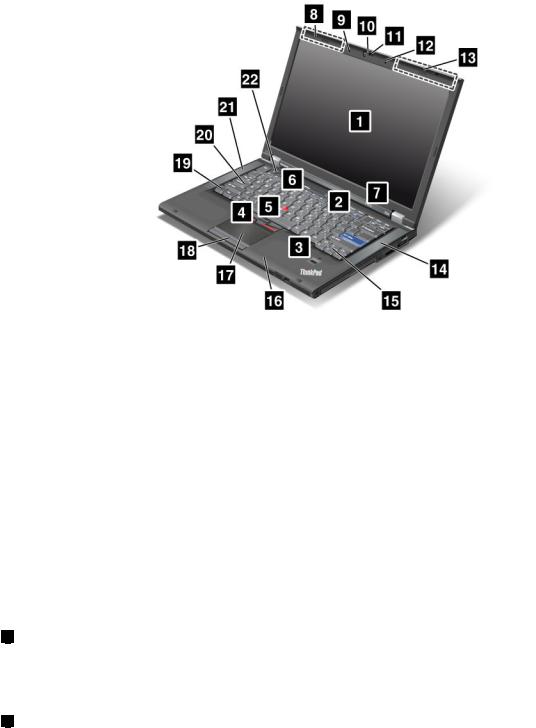
Front view
Figure 1. ThinkPad T420/T420i front view
|
|
|
Computer display |
|
|
|
Power switch |
|
1 |
|
|
2 |
|
||
|
|
|
|
|
|
|
|
|
|
|
Fingerprint reader |
|
|
|
TrackPoint buttons |
|
3 |
|
|
4 |
|
||
|
|
|
|
|
|
|
|
|
|
|
TrackPoint pointing stick |
|
|
|
ThinkVantage button |
|
5 |
|
|
6 |
|
||
|
|
|
|
|
|
|
|
|
|
|
System and power-status indicators |
|
|
|
UltraConnect wireless antennas (left) |
|
7 |
|
|
8 |
|
||
|
|
|
|
|
|
|
|
|
|
|
Built-in microphone (left) |
|
|
|
Integrated camera |
|
9 |
|
|
10 |
|
||
|
|
|
|
|
|
|
|
|
|
|
ThinkLight |
|
|
|
Built-in microphone (right) |
|
11 |
|
|
12 |
|
||
|
|
|
|
|
|
||
|
|
|
UltraConnect wireless antennas (right) |
|
|
|
Built-in stereo speaker (left) |
|
13 |
|
|
14 |
|
||
|
|
|
|
|
|
||
|
|
|
Forward and Back keys |
|
|
|
Bluetooth antenna |
|
15 |
|
|
16 |
|
||
|
|
|
|
|
|
||
|
|
|
Touch pad |
|
|
|
Touch pad buttons |
|
17 |
|
|
18 |
|
||
|
|
|
|
|
|
||
|
|
|
Fn key |
|
|
|
CapsLock key indicator |
|
19 |
|
|
20 |
|
||
|
|
|
|
|
|
||
|
|
|
Built-in stereo speaker (left) |
|
|
|
Volume control buttons |
|
21 |
|
|
22 |
|
||
|
|
|
|
|
|
|
|
1 |
Computer display |
The high-resolution, thin-film transistor (TFT) display provides clear and brilliant text and graphics. For details, refer to the instructions in “Changing display settings” on page 69.
2 |
Power switch |
Use the power switch to turn on the computer. To turn off your computer, use the Start menu shutdown options.
If you cannot turn off the computer by this method, press and hold the power switch for 2 seconds.
2 User Guide

If your computer stops responding, and you cannot turn it off, press and hold the power switch for 4 seconds or more. If the system is still not reset, remove the ac power adapter and the battery.
3 |
Fingerprint reader |
Some models have a fingerprint reader. The fingerprint authentication technology enables you to use your fingerprint to start the computer and enter the ThinkPad Setup.
For details, refer to the instructions in “Using a fingerprint reader” on page 97.
UltraNav® |
|
4 |
TrackPoint buttons |
5 |
TrackPoint pointing stick |
17Touch pad
18Touch pad buttons
The keyboard contains the unique TrackPoint® pointing device. Pointing, selecting, and dragging are all part of a single process that you can perform without moving your fingers from typing position.
Move your fingertip across the UltraNav touch pad to move the pointer.
The TrackPoint and touch pad buttons provide functions similar to those of a mouse and its buttons.
6 |
ThinkVantage button |
Press the ThinkVantage button to launch the SimpleTap program (for Windows® 7) or the ThinkVantage Productivity Center program (for Windows XP and Windows Vista®).
Note: Depending on the date when your computer was manufactured, your computer might have the Lenovo ThinkVantage Toolbox program preinstalled instead of the SimpleTap program or the ThinkVantage Productivity Center program.
You also can use the ThinkVantage button to interrupt the startup sequence of your computer and start the Rescue and Recovery® workspace. For more information, see “ThinkVantage button” on page 27.
7 |
System and power-status indicators |
Your computer has the system status indicators and the power status indicators. For the detailed information about the location and meaning of each indicator, see “System-status indicators” on page 11 and “Power-status indicators” on page 12.
8 UltraConnect™ wireless antennas (left)
13 UltraConnect wireless antennas (right)
The built-in antennas for the wireless communication are located at the top left and the top right portions of your computer display.
For the specific locations of each antenna, refer to “Location of the UltraConnect wireless antennas” on page 238.
9 Built-in microphone (left)
12 Built-in microphone (right)
The built-in microphone captures sound and voice when it is used with an application program capable of handling audio.
Chapter 1. Product Overview 3

10 |
Integrated camera |
Some models have an integrated camera. By using this camera, you can take pictures or hold a video conference.
For more information about how to use the camera, refer to “Using an integrated camera” on page 78.
11 |
ThinkLight |
You can use your computer under less than perfect lighting conditions.
To illuminate the keyboard, turn on the ThinkLight® by pressing Fn+PgUp. To turn it off, press Fn+ PgUp again.
14 |
Built-in stereo speaker (right) |
21 |
Built-in stereo speaker (left) |
The stereo speakers are built into your computer.
For details, refer to the instructions in “Volume and mute buttons” on page 32.
15 |
Forward and Back keys |
The Forward and Back keys on your keyboard near the cursor-control keys are used with your Internet browser, such as Internet Explorer®. They function like the forward and back arrows in the browser that move you back and forward to pages you have viewed in the order that you opened them.
16 |
Bluetooth antenna |
If your computer has integrated bluetooth features, refer to “Using Bluetooth” on page 44 for more information.
19 |
Fn key |
Use the Fn key to take advantage of ThinkPad® functions, such as turning on the ThinkLight. To use ThinkPad functions, press Fn + the required function key marked in blue.
20 |
CapsLock key indicator |
The indicator of CapsLock is located on the CapsLock key.
For more information about CapsLock indicator, see “System-status indicators” on page 11.
22 |
Volume control buttons |
The built-in volume buttons enable you to quickly adjust the volume or mute the sound from your computer.
For details, refer to the instructions in “Volume and mute buttons” on page 32.
4 User Guide
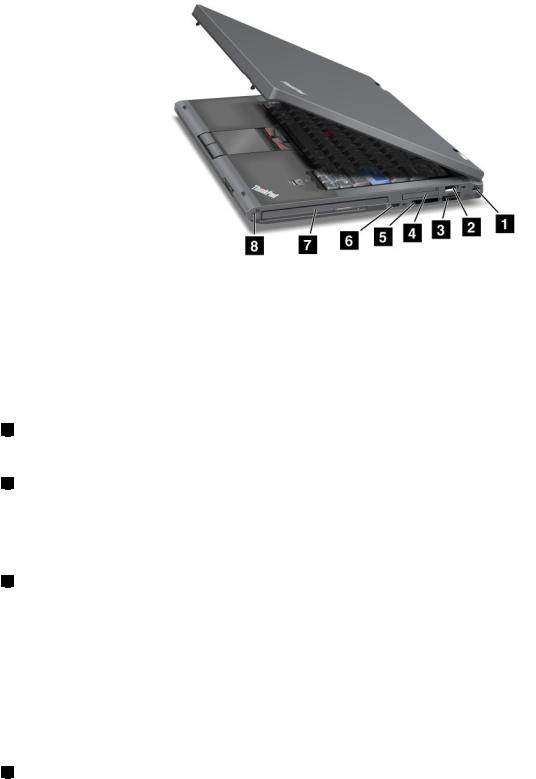
Right-side view
Figure 2. ThinkPad T420/T420i right-side view
|
|
Security keyhole |
|
|
USB connector |
|
1 |
|
2 |
||
|
|
|
|
|
|
|
|
eSATA/USB combo connector |
|
|
ExpressCard slot |
|
3 |
|
4 |
||
|
|
|
|
|
|
|
|
Media card reader slot |
|
|
Wireless radio switch |
|
5 |
|
6 |
||
|
|
|
|
|
|
|
|
Serial Ultrabay enhanced |
|
|
Combo audio jack |
|
7 |
|
8 |
||
|
|
|
|
|
|
1 |
Security keyhole |
Your computer comes with a security keyhole. You can purchase a security cable and lock to fit this keyhole.
2 |
USB connector |
The Universal Serial Bus connector is used for connecting devices compatible with a USB interface, such as a printer or a digital camera.
Note: Your computer is compatible with USB 1.1 and 2.0.
3 |
eSATA/USB combo connector |
The Universal Serial Bus connectors are used for connecting devices compatible with a USB interface, such as a printer or a digital camera.
Note: Your computer is compatible with USB 1.1 and 2.0.
You can also connect an external SATA device, such as an external hard disk drive, to this connector on some models.
Note: To avoid damaging the connector, be careful when you attach a cable from the external SATA device to the connector.
4 |
ExpressCard slot |
Your computer has the ExpressCard slot for a 34 mm-wide card.
Chapter 1. Product Overview 5

For details, refer to the instructions in “Using the media card reader” on page 79.
5 |
Media card reader slot |
Depending on the model, your computer may have a media card reader slot. The media card reader supports the following cards:
•SD card
•SDHC card
•SDXC card
•MultiMediaCard
Note: Your computer does not support CPRM feature for SD card.
For details, refer to the instructions in “Using the media card reader” on page 79.
6 |
Wireless radio switch |
You can quickly turn the wireless features of your computer on and off using this switch.
7 |
Serial Ultrabay enhanced |
Your computer has a bay for serial Ultrabay™ enhanced devices. An optical drive is installed in the bay.
Note: You can install a 9.5-mm-thick serial Ultrabay slim or a 12.7-mm-thick serial Ultrabay enhanced device in the serial Ultrabay enhanced.
8 |
Combo audio jack |
To listen to the sound from your computer, connect a headphone or a headset that has a 3.5mm 4-pole plug, to the combo audio jack.
Notes:
•If you are using a headset with a function switch, for example, a headset for an iPhone® mobile digital device, do not press this switch while using the headset. If you press it, the headset microphone will be disabled, and the internal microphone will be enabled instead.
•The combo audio jack does not support a conventional microphone. For more information about the audio devices supported by the combo audio jack of your computer and the audio jacks of ThinkPad Mini Dock Series 3 and ThinkPad Mini Dock Plus Series 3, and ThinkPad Mini Dock Plus Series 3 (170 W), see “Using audio features” on page 77.
6 User Guide
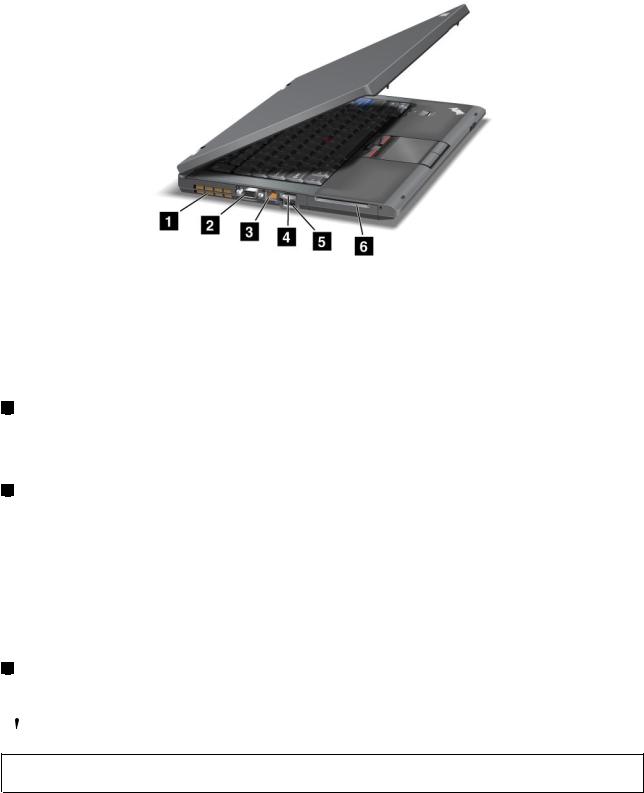
Left-side view
Figure 3. ThinkPad T420/T420i left-side view
|
|
Fan louvers (left) |
|
|
Monitor connector |
|
1 |
|
2 |
||
|
|
|
|
|
|
|
|
Ethernet connector |
|
|
DisplayPort connector |
|
3 |
|
4 |
||
|
|
|
|
|
|
|
|
USB connector (left) |
|
|
Smart card slot |
|
5 |
|
6 |
||
|
|
|
|
|
|
1 |
Fan louvers (left) |
The internal fan and louvers enable air to circulate in the computer and cool the central processor.
Note: To avoid impeding airflow, do not place any obstacle in front of the fan.
2 |
Monitor connector |
You can attach an external monitor or a projector to your computer to display computer information.
Note: If you attach your computer to the ThinkPad Port Replicator Series 3, ThinkPad Mini Dock Series 3, ThinkPad Mini Dock Plus Series 3, and ThinkPad Mini Dock Plus Series 3 (170 W) and use a monitor
connector, use the monitor connector on the ThinkPad Port Replicator Series 3, ThinkPad Mini Dock Series 3, ThinkPad Mini Dock Plus Series 3, and ThinkPad Mini Dock Plus Series 3 (170 W), not the one on the computer.
For details, refer to the instructions in “Attaching an external monitor” on page 70.
3 |
Ethernet connector |
Connect your computer to a LAN with the Ethernet connector.
 DANGER
DANGER
To avoid the risk of electrical shock, do not connect the telephone cable to the Ethernet connector. You can only connect an Ethernet cable to this connector.
Chapter 1. Product Overview 7
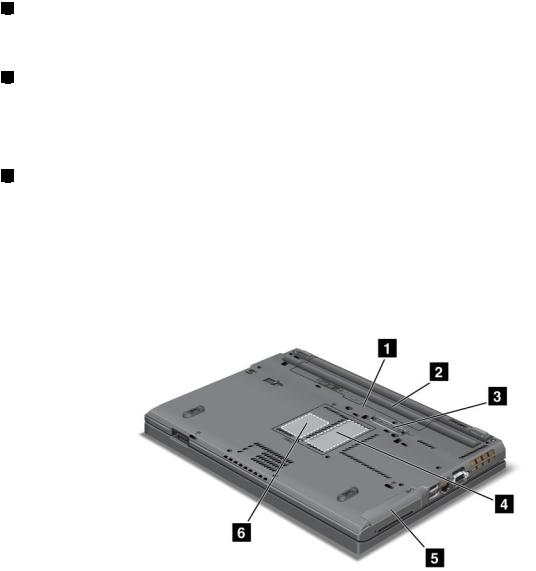
Two indicators, to the lower right and left of the connector, show the status of the network connection. When your computer connects to a LAN and a session with the network is available, the lower right indicator is solid green. While data is being transmitted, the lower left indicator blinks yellow.
For details, refer to the instructions in “Access Connections” on page 20.
Note: If you attach your computer to the ThinkPad Port Replicator Series 3, ThinkPad Mini Dock Series 3, ThinkPad Mini Dock Plus Series 3, and ThinkPad Mini Dock Plus Series 3 (170 W) and use an Ethernet connector, use the Ethernet connector on the ThinkPad Port Replicator Series 3, ThinkPad Mini Dock Series 3, ThinkPad Mini Dock Plus Series 3, and ThinkPad Mini Dock Plus Series 3 (170 W), not the one on the computer.
4 |
DisplayPort connector |
Your computer supports the DisplayPort, a next-generation digital display interface that connects a compatible projector, external monitor, or HDTV to your computer.
5 |
USB connector (left) |
The Universal Serial Bus connectors are used for connecting devices compatible with a USB interface, such as a printer or a digital camera.
Note: Your computer is compatible with USB 1.1 and 2.0.
6 |
Smart card slot |
Your computer has the Smart card slot.
For details, refer to the instructions in “Using the media card reader” on page 79.
Bottom view
Figure 4. ThinkPad T420/T420i bottom view
8 User Guide
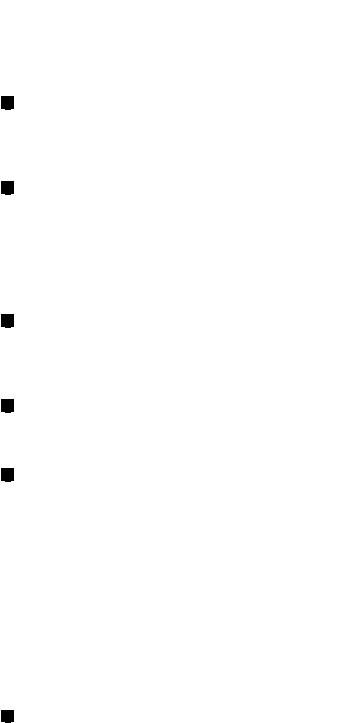
|
|
SIM card slot |
|
|
Battery |
|
1 |
|
2 |
||
|
|
|
|
|
|
|
|
Docking connector |
|
|
Memory-upgrade slot |
|
3 |
|
4 |
||
|
|
|
|
|
|
|
|
Hard disk drive or solid state drive |
|
|
PCI Express Mini Card slot for wireless WAN card or |
|
5 |
|
6 |
||
|
|
|
|
mSATA solid state drive |
|
|
|
|
|
|
|
1 |
SIM card slot |
If your computer has a wireless WAN feature, it may require a SIM (Subscriber Identification Module) card to establish a wireless WAN (Wide Area Network) connections. Depending on the country of delivery, the SIM card may be already installed in the SIM card slot.
2 |
Battery |
Use your computer with battery power whenever ac power is unavailable.
By installing a second battery, available as an option, in the serial Ultrabay slim, you can extend the operating time of the computer. You can also use Power Manager to adjust your power setting as needed.
For details, refer to the instructions in “Power Manager” on page 23.
3 |
Docking connector |
With a ThinkPad Port Replicator Series 3, ThinkPad Mini Dock Series 3, ThinkPad Mini Dock Plus Series 3, and ThinkPad Mini Dock Plus Series 3 (170 W), you can extend the computer capabilities when you are in your office or at home.
4 |
Memory-upgrade slot |
You can increase the amount of memory in your computer by installing a memory module in the memory bay. Memory modules are available as options.
5 |
Hard disk drive or solid state drive |
Your computer may have a large-capacity, customer-upgradable hard disk drive that can meet a variety of storage demands. To keep the drive safe, Active Protection System™ is installed on your computer. For details, refer to “Active Protection System” on page 21.
If you wish, you can purchase another hard disk drive and install it in the serial Ultrabay slim.
With Lenovo® technologies advancing to provide you with the best engineered systems, some models are equipped with a solid state drive for data storage. This cutting-edge technology enables notebook computers to be lighter, smaller and faster.
Note: The hidden service partition is the reason why there is less free space than expected on your hard disk drive or solid state drive drive. This reduction is more noticeable on the solid state drive drive because of its smaller capacity.
6 |
PCI Express Mini Card slot for wireless WAN card or mSATA solid state drive |
Your computer might include a PCI Express Mini Card in the PCI Express Mini Card slot which enables wireless WAN communications.
With Lenovo technologies advancing to provide you with the best engineered systems, some models are equipped with a mSATA solid state drive for data storage.
Chapter 1. Product Overview 9
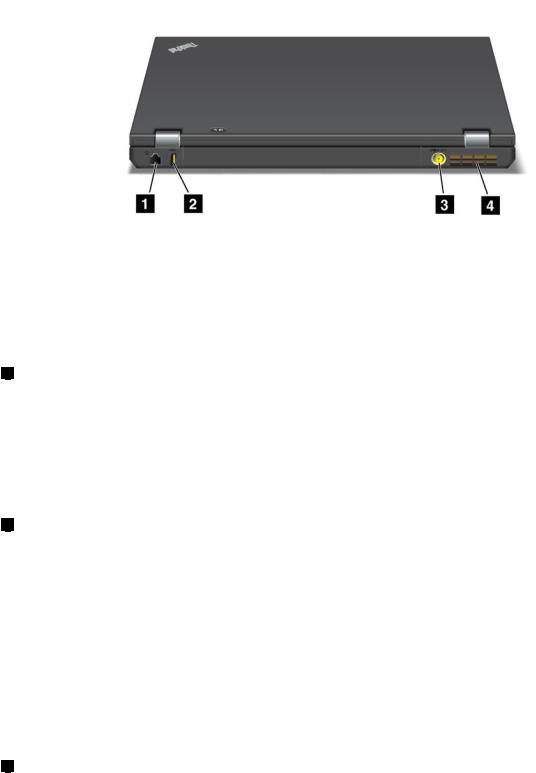
Rear view
Figure 5. ThinkPad T420/T420i rear view.
|
|
Modem connector or IEEE 1394 |
|
|
Always On USB connector (rear) |
|
1 |
|
2 |
||
|
|
|
|
|
|
|
|
Power jack |
|
|
Fan louvers (rear) |
|
3 |
|
4 |
||
|
|
|
|
|
|
1Modem connector or IEEE 1394
•If your computer has a modem connector, connect your computer to a telephone line with the modem connector. For details, refer to the instructions in “Dialup connections” on page 68.
•If your computer has an IEEE 1394 connector, which is used for connecting devices that are compatible with the IEEE 1394 interface, such as digital video cameras and external hard disk drives.
Note: Depending on your model, your computer might have neither modem connector nor IEEE 1394 connector.
2 |
Always On USB connector (rear) |
The Always On Universal Serial Bus connector is used for connecting devices compatible with a USB interface, such as a printer or a digital camera.
By default, even if your computer is in sleep (standby) mode, the Always On USB connector still enables you to charge some devices, such as iPod®, iPhone, and BlackBerry® smartphones, by attaching the devices to the connector.
However, with the ac power adapter attached, if you want to charge these devices when your computer is in hibernation mode or powered off, you will need to open the Power Manager program and configure corresponding settings to enable the Always On USB connector function. For details about how to enable the Always On USB connector function, refer to the on-line help of the Power Manager program.
Note: Your computer is compatible with USB 1.1 and 2.0.
3 |
Power jack |
The ac power adapter cable connects to the computer power jack to provide power to the computer and charge the battery.
10 User Guide
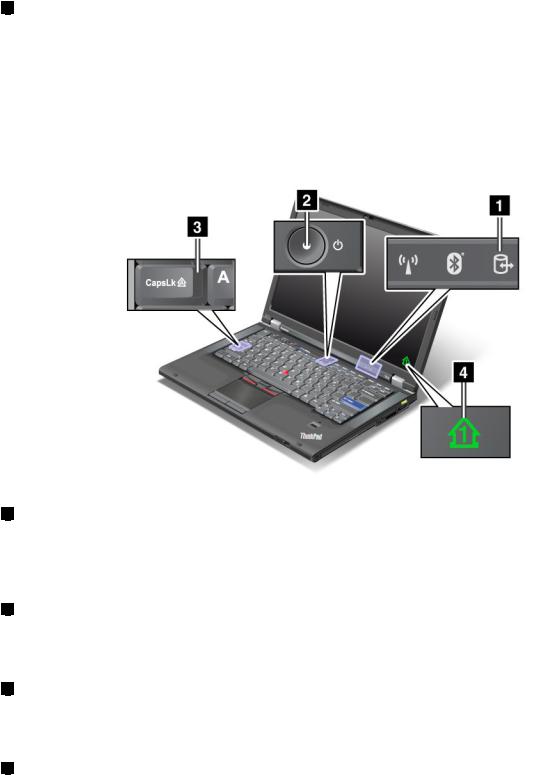
4 |
Fan louvers (rear) |
The internal fan and louvers enable air to circulate in the computer and cool the central processor.
Note: To avoid impeding airflow, do not place any obstacle in front of the fan.
Status indicators
The status indicators show the current status of your computer.
System-status indicators
1 |
Device Access |
A hard disk drive or an optional drive, such as a drive in the Ultrabay, is being used to read or write data.
When this indicator is blinking, do not put the computer into sleep (standby) mode, remove the device from the bay, or turn off the computer.
2 |
Power On |
The power switch stays lit whenever the computer is on, blinks when the computer is in sleep (standby) mode, and is off when the computer is off.
3 |
Caps Lock |
Caps Lock mode is enabled. You can enter all alphabetic characters (A-Z) in upper case without pressing the Shift key.
4 |
Numeric lock |
By default, when the numeric lock is on, the numeric lock indicator is displayed on the screen. To change the settings of the numeric lock indicator, see “Changing display settings” on page 69.
Note: Another mode available for your computer, though there is no indicator for it, is Scroll Lock mode. When this mode is enabled, the arrow keys can be used as function keys for screen-scrolling, but not for
Chapter 1. Product Overview 11
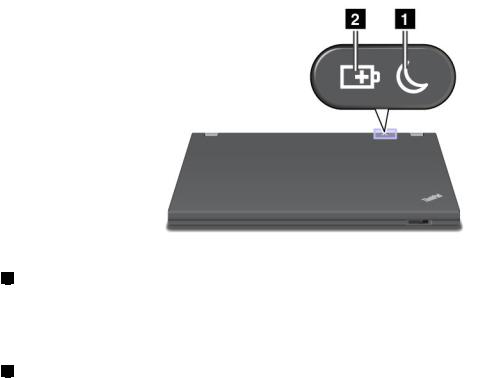
moving the cursor. To enable or disable this mode, press ScrLk. Not all application programs support this function.
Power-status indicators
The computer has status indicators that show the mode (sleep/standby, hibernation, or normal), ac power status, the status of the battery. The following shows the location and the meaning of the indicators:
1Sleep (standby in Windows XP) status
•Green: The computer is in sleep (standby) mode.
•Blinking green: The computer is entering sleep (standby) or hibernation mode, or is resuming normal operation.
2Battery status
•Green: The battery has more than 20% charge.
•Orange: The battery has between 5% and 20% charge
•Fast blinking orange: The battery has less than 5% charge.
Note: The battery may be charging.
•Slow blinking orange: The battery is being charged. When it reaches 20%, the blinking color changes to green.
•Slow blinking green: The battery has between 20% and 80% charge, and charging is continuing. When the battery reaches 80% charge, blinking stops, but the charging may continue until the battery is 100% charged.
Note: If the computer is operating on battery power, the Battery status indicator does not work while the computer is turned off or is in sleep (standby) mode or hibernation mode.
•Quick blinking orange: An error has been occurred in the battery.
•The battery status indicator blinks three times: The ac power adapter is attached to the computer.
•The battery status indicator is off: The battery is fully charged or the battery is detached.
12 User Guide
